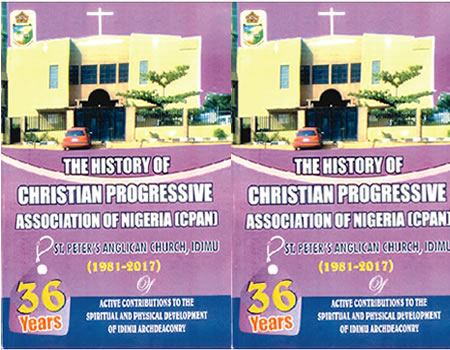EVERY organisation, whether religious, social or corporate; has a history of its own. And so does the Christian Progressive Association of Nigeria (CPAN), a society founded by some vibrant members of the St. Peter’s Anglican Church, Idimu, Lagos and sustained through the past 36 years.
The book, The History of Christian Progressive Association of Nigeria, written by Adedeji Komolafe, a retired mechanical engineer and ex-president of the group, clearly sets out to celebrate an era of inspiring leadership and achievements by the CPAN, as well as its invaluable contributions to the spiritual and physical development of the Idimu Archdeaconry.
The CPAN is described as essentially the product of a fusion of two Christian societies founded for the sole purpose of making active contributions to the growth of the church. Both societies, the book stresses, were established between 1981 and 1991. In principle, the birthing process of the CPAN could well have started within this period.
Then, in typical flashback fashion, the narrative takes us backward in time to the beginning of St. Peter’s Anglican Church. Here, history assumes its natural role of exposing the ties that exists between this society and its parent body.
The first phase of the church’s history, which stretches from 1914 to 1980, also accounts for its small beginning as a mere seedling planted by an ex-convict at a time the then inhabitants of the Idimu community were still neck-deep in pagan worship.
Through sheer hard work and diligence, Tako Sanbelalu and his followers were able to plant the church in the community and supervise its growth until a period in the future when the rest of the ecumenical work fell on the shoulders of non-indigenes.
The second phase, 1981 to the present day, witnessed the rapid spiritual and physical development of the church. The roles played by individuals, families and societies, especially the CPAN, whose contributions have been largely instrumental to the elevation of the church to the level of an Archdeaconry seat in the Diocese of Lagos West at this point in its history, are highlighted in the book.
One of the families, the Olorunyomi family, earns a special mention. It is acknowledged for encouraging and supervising an early influx of new settlers, who would later spearhead the all-important drive for the development of the Idimu community and the church.
Chapter three highlights the contributions to and influence of societies, such as the Egbe Itesiwaju Kristi, the Idimu Social Elite and the Christian Progressive League in the birth of the CPAN and subsequently, in the overall development of St. Peter’s Anglican Church.
The church, we are informed in Chapter four, is indebted to the CPAN in terms of administration. Although the latter’s contributions are best described as unquantifiable in the book, the following words suffice to prove that majority of its members were extraordinarily committed: “When the society was founded in 1981, majority of the members were in their thirties. They were young, strong and adventurous. They were willing to spend their time and time for the propagation of the gospel of Jesus Christ.
“In the 1980s and early 1990s, St. Peter’s Anglican Church, Idimu, could be likened to a typical African Family with CPAN as the First Son. The society was involved in all decision making efforts of the church. Nothing was done outside CPAN.”
This is, by all means, a worthy testimony. The tempo is sustained throughout the narrative. The association is also portrayed as being vital to the evangelical mission of the church, often leading the way whenever duty called. More important, it was instrumental to the emergence of the Idimu Area Group of Churches between 1986 and 1989, the development of infrastructure in the church and the founding of the St. Peter’s Choral Group, among other contributions.
Since any society is as good as its membership, Pa Komolafe has deemed it necessary to pay tribute in the concluding chapters to some worthy members of the CPAN whose contributions have also helped to dictate the pace of the spiritual and physical development of the church and the Idimu community these past 36 years. The list is almost exhaustive.
However, for some reason best known to him, the author appears to have deliberately left out the sour points in the joint history of the CPAN and the St. Peter’s Anglican Church. But then, this book is written in a celebratory mood.






